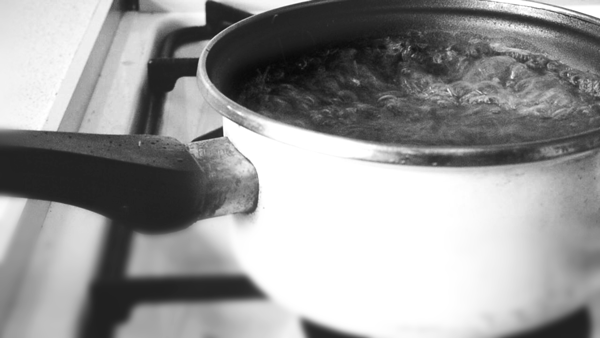
________________
Ryoichi Kurokawa Outfalls (2011)
It is an audiovisual installation consisting of 8 rectangular HD displays and 8ch multi sound hanging at different heights from the ceiling and arranged to form a circle. The screens project videos of various waterfalls in movement, whose sound echoes through the speakers in the Arsenale. The audiovisual performance has a duration of 8 minutes. Initially the visitor seems to be immersed in a dimension of peace until the showing suddenly stop and the screens start to alternate with each other in the reproduction of the video, creating a sense of anxiety. The movement of the waterfalls accelerates, stops, is reversed and finally restored in an aggressive or peaceful way, always emphasized through the use of the sound.
________________
Anish Kapoor Descension (2014)
________________
Jo Broughton Ice Cave (from the series Empty Porn Sets) (2010)
In her series Empty Porn Sets, by recording spaces left behind after the human activity, Jo Broughton makes a strong statement against a voyeuristic or judgemental look at the processes of making porn, withdrawing from any moral discourse. The emptiness depicted has the effect of mainlining emotional reverb into the space.
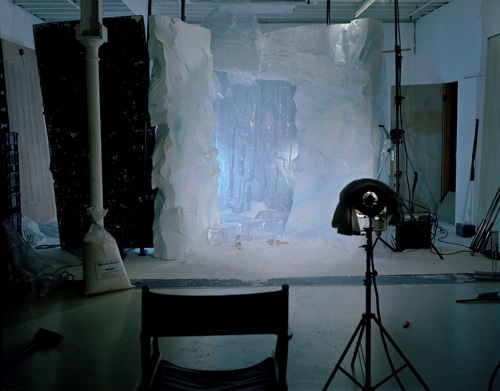
_______________
Finnbogi Pétursson Sphere (2003)
Icelandic artist Finnbogi Pétursson’s work combines sculpture and architecture with sound, using single repetitive tones, emitted at precise intervals from speakers throughout the installations, to create sound wave “sculptures” in the air. In essence, Pétursson’s work makes sound visible. Not surprisingly, he has built a reputation among jazz, classical and experimental musicians and throughout the arts community as a major innovator, blending high- and low-tech media to create sound sculptures that play upon sound, vision and the capture of light, within the context of the natural world.
_______________
David Zink Yi Untitled (Architeuthis)
Untitled (Architeuthis), a massive sculpture of the ancient sea squid that since pre-historic times has dwelt at the ocean’s darkest depths. The subject of lore and fine art for centuries, the Architeuthis emerges to human view only at its death, when it washes onto shore and is deposited at the border where the opposing but interdependent worlds of land and sea meet. Zink Yi’s dying squid sprawls across the gallery floor, a body without breath. Its 16-foot, deflated, creamy pale form rests in a pool of glistening dark liquid. Looking like tons of dead animal protein, Zink Yi’s Architeuthis is in fact a 660-pound ceramic object achieved through a tremendously difficult process that pushes the material to the very limits of its potential.

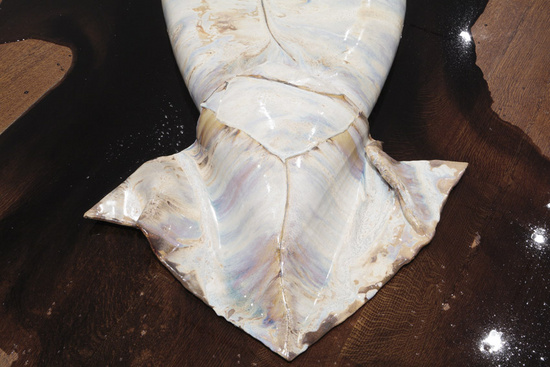
________________
Greatest Hits Aquae Profundo (2011)
Being raised in the Soviet system, where tales of abduction by aliens or UFOs meant that you too may soon be taken by psychiatrists, I was not very keen on discussing my encounters publicly for years. When I looked at this work I thought there must be another tautology at play, a double or even triple cliché of familiarity. Together with predictability, here lies the essence of contemporary art: it has to be predictable enough and codified so that it can be consumed in one way or another. Yet the artwork faces a demand for newness, unscripted and unknown. This frozen creature represents a balance of forces (physical and ideological) that makes it possible as an artifice of contemporary art. This is indeed brilliant. But does this make me more curious than a discussion about the genealogy of Raelians? I don’t know. I don’t know if it teaches me any new ways of reasoning and perceiving. What it does do is push the status quo, and maybe there is a twist-at-the-end kind of moment when you suddenly realise that everything you took for granted is in fact something completely different. Maybe the fact that this sculpture will melt is enough. It may even encourage one to abolish the structures that preserve it — or to buy a more powerful freezer. If the work melts before we make conclusions about it — perhaps the best thing that could happen — it will allow us to have a continuing conversation, rather than put these ideas back on the shelf.
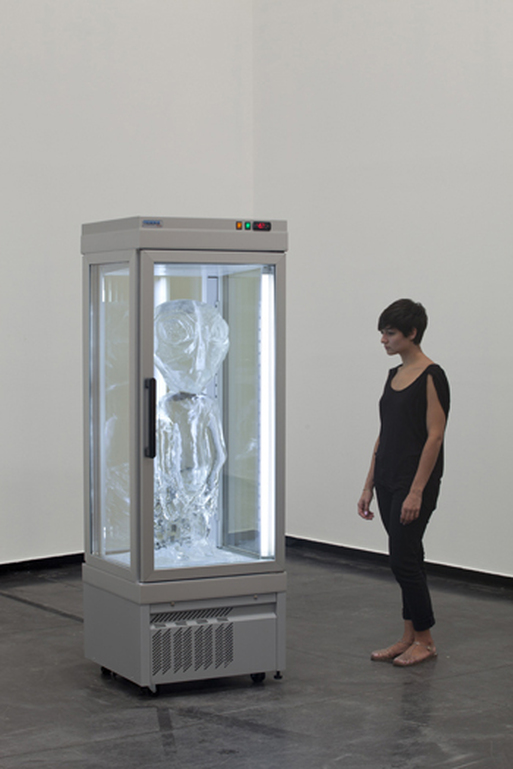
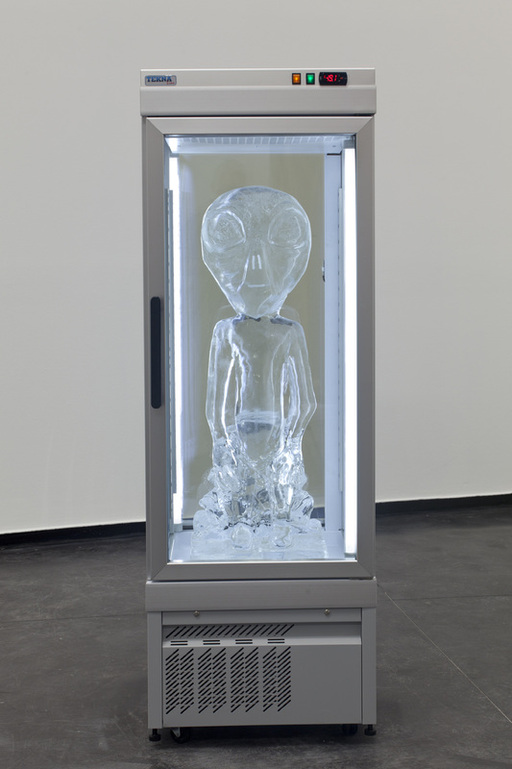
_______________
Olafur Eliasson Riverbed (2014)
Described as a “stress-test of the Louisiana Museum’s physical capacity” the installation Riverbed by Olafur Eliasson is a staged imitation of a natural landscape within the walls of one of Denmark’s important Modernist buildings. Visitors can walk on the rocky surface, which slopes up towards the sides of a series of rooms that make up the museum’s south wing. A narrow path running through the spaces has been filled with water to recreate the trickle at the bottom of a dried river.
________________
Soo Jin Ahn Stereo Water Tank (2010)
________________
Manfred Kielnhofer Guardians of Time (2015)
Manfred Kielnhofer’s Guardians of Time relates to the idea that since the beginning of time mankind has had protectors, both for historic and mystical reasons. It seems that only man himself is a potential source of danger for his own existence. In his works of art Manfred Kielnhofer deals with the natural human desire for security.

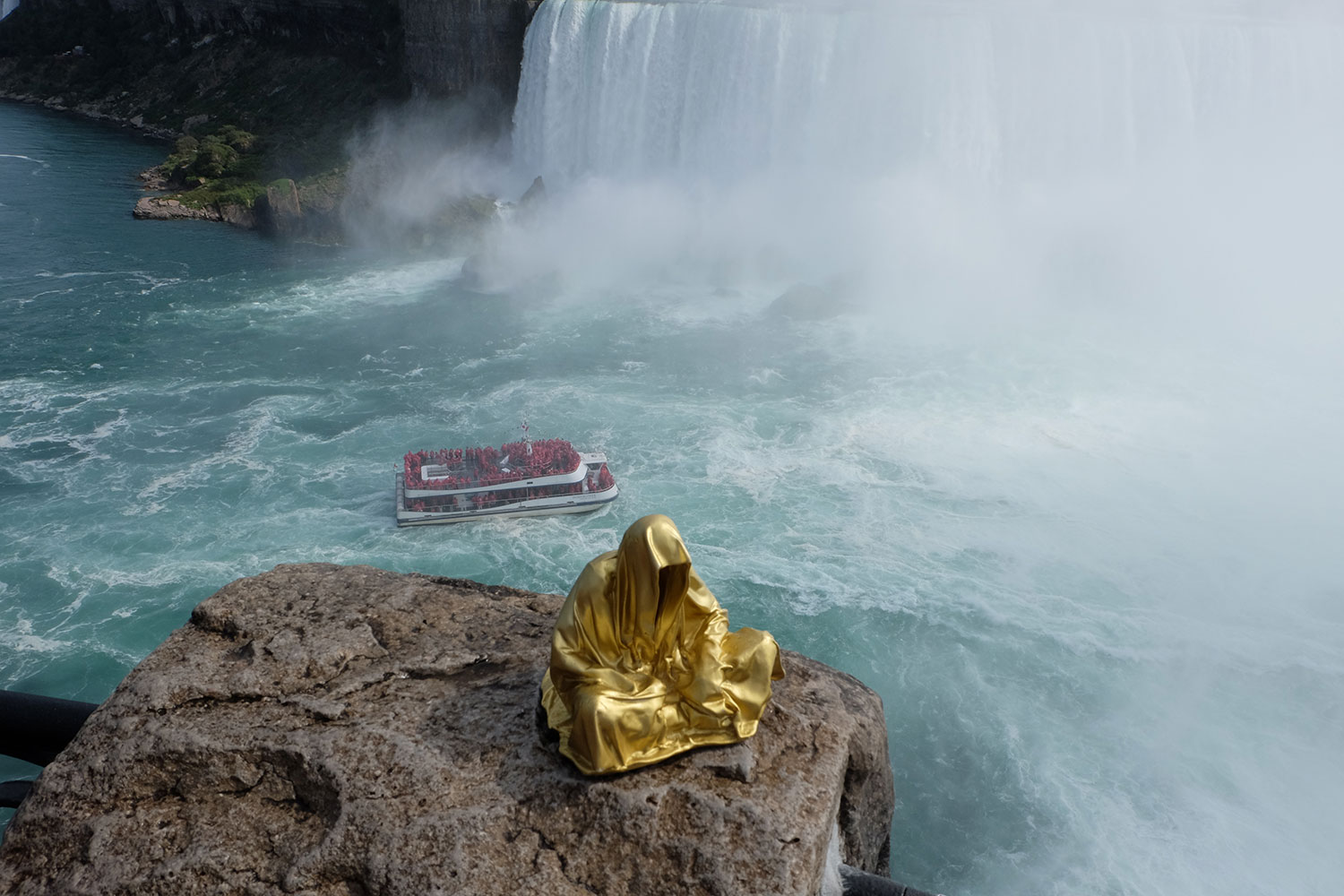
_______________
Rebeca Méndez At any given moment (2009)
Rebeca Méndez is a Mexican artist born in 1962 who works using various media such as photography, video and installation. A constant theme in her works is the flow of water in waterfalls and rivers.
_____________
Tokujin Yoshioka Water Bench (2012)
A bench designed by Tokujin Yoshioka. The material used in this bench is a special glass which is used on the space shuttle. This material is made from a 4.5 meter giant optical glass block. At the surface, you can see a beautiful pattern of running water.

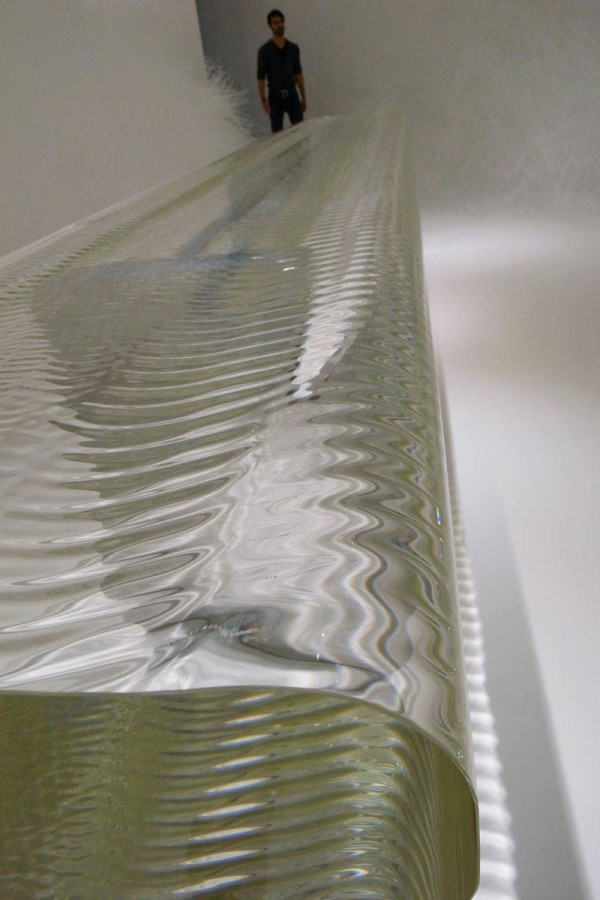
_____________
Beili Liu Thirst (2013)
During the autumn of 2013, the Chinese artist Beili Liu created Thirst, a site-specific artwork exhibited on Lady Bird Johnson Lake in Austin, Texas. It was a work created to denounce the severe water crisis which hit Texas after a drought that killed millions of trees. The installation consisted of a drought-killed cedar elm tree painted white and supported by a pole in the middle of the lake. The roots of the tree barely reached the surface of the water without touching it, thus increasing the tragic nature of the work: the tree was deprived of water, the element that gives it life. It was alone, decadent and thirsty.

______________
Cai Guo-Qiang Heritage (2013)
99 life-sized replicas of animals. Animals: polystyrene, gauze, resin and hide. Installed with artificial watering hole: water, sand, drip mechanism.
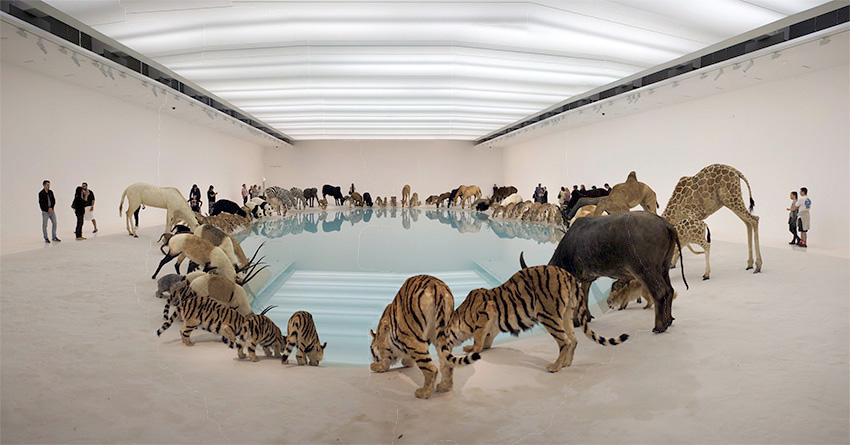

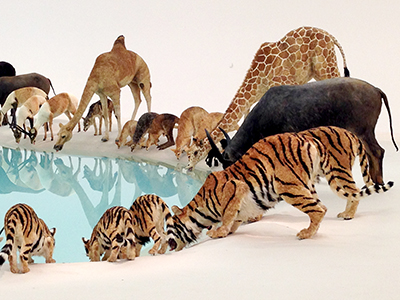
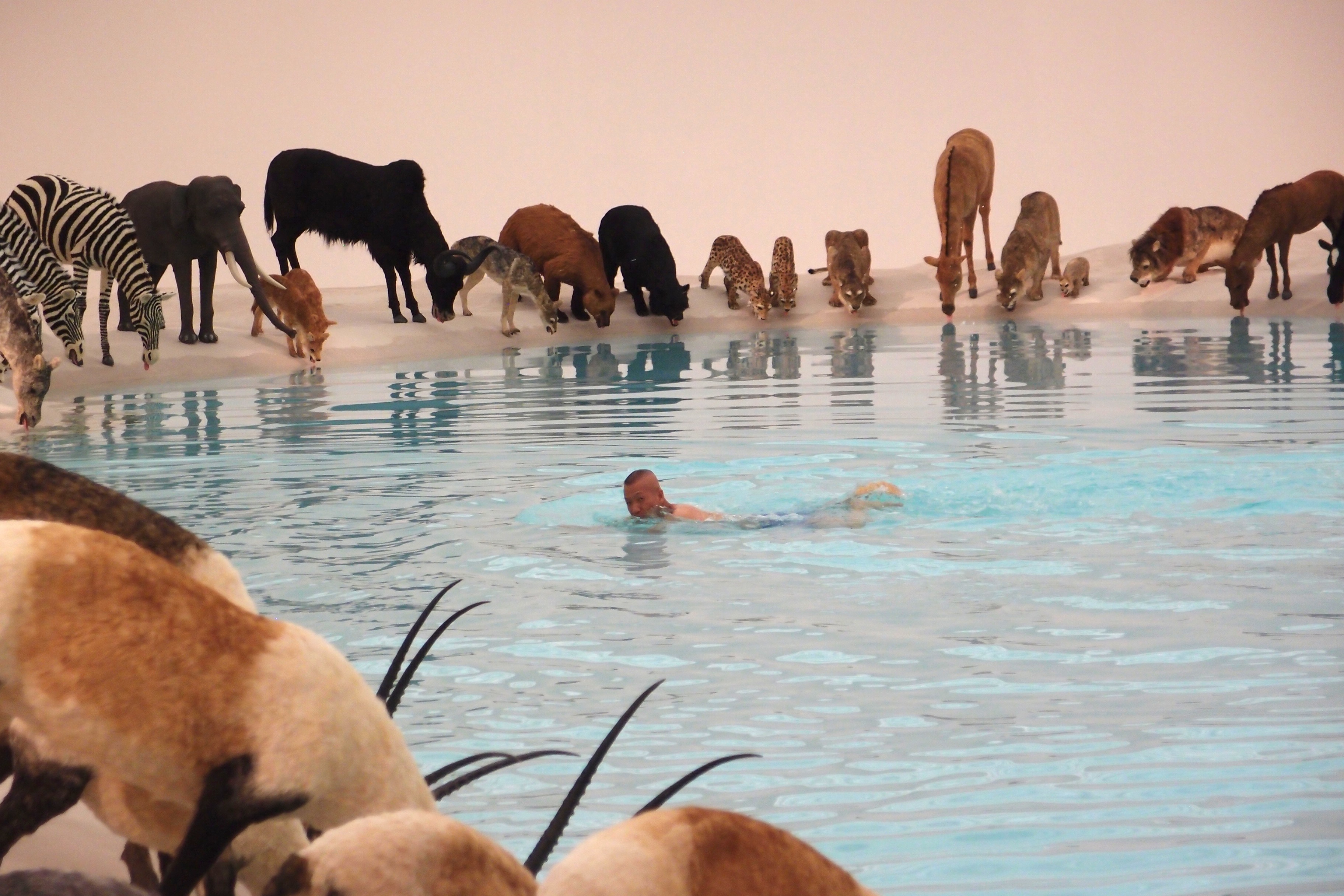
______________
Céleste Boursier-Mougenot Clinamen (2013)
In Clinamen white porcelain bowls float on the surface of an intensely blue pool. Circulating gently, swept along by submarine currents, floating crockery acts as a percussive instrument, creating a resonant, chiming acoustic soundscape marked by complexity, hidden patterns and chance compositions.
______________
Fabrizio Plessi Various works (1999-2010)




____________
Rúrí Vocal IV (2008)
In her series of works called Vocals, the Icelandic artist Rúrí wants to give life to the voice of the waterfalls through Video Art Installations. “A mighty waterfall has a mighty awe-inspiring voice. But if the water flow dwindles or the water disappears that voice will die” the artist says. Vocal IV is an elaborate performance created in collaboration with musician and composer Jóhann Jóhannsson with diverse elements- video, music, sound art, waterfall swish, nature sounds and texts from the international discussion that Rúrí has collected about water. This is the first time Rúrí has worked with a composer for a performance. Together Rúri and Jóhann have teamed up with an Icelandic choir, Matthias Hemstock, percussionist player, and a group of electric guitar players to create a vast soundscape.
______________
Gabriel Orozco Ping Pond Table (1998)
The Ping Pond Table is connected to this idea of a new space, a new possible space. When you have a normal ping-pong game, you have a net, which is enough space between two spaces. But when you multiply that space by four, instead of two people playing, you have four people playing in four tables. You open that space so the net is also open. And what you have there is a new space because it didn’t exist before. I’m thinking in a new game, when I multiply by four the knights in the chessboard, or when I made the pendulum and the billiard table. In this case, I opened the ping-pong—the net, that space in between two spaces—I opened it up. And I have a tri-dimensional space now, in between four spaces. So, in this case, it’s the net, the limit, and the border between two spaces. I opened that border, and it became tri-dimensional, a space in itself. And that’s why I decided to make the pond. I could decide to make anything I wanted. It could be a rug or sand or nothing. But then I liked the idea because the shape of the table has to be round. It’s round because you have to move; waiting for the bounce from three different tables, you have to move much more than in a normal ping-pong table. I liked the idea of the pond and the lotus. If you want to think in a metaphorical sense, of the lotus flower as the beginning of the universe, I think you can do that because it’s a new game. It’s a new space for a new way of playing with the universe, which is this game. I think every game is a universe, in a way, or every game is an expression of how the universe works for different cultures. Ping-pong is a game about the universe playing, or is a game about how the universe is so arbitrary and how it’s constant.

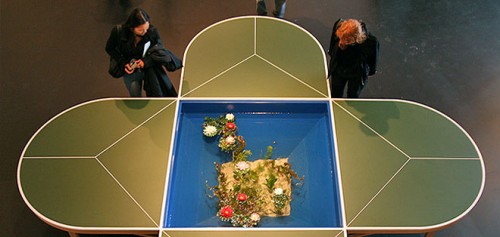

_______________
Nicolas Consuegra The Water that you Touch is the Last of What has Passed and the First of that Which Comes (2013)
The La Central gallery dedicated all of its Art Basel space to Nicolas Consuegra’s 15 channel video installation The Water that you Touch is the Last of What has Passed and the First of that Which Comes. It chronicled the Magdalena river as it runs through a depressed small town outside of Bogotá. Presented as a moving ring, the river becomes a sensual emblem of rushing infinitudes and potential for a town that is in socioeconomic stagnation.
______________
Marie Toseland Being and Nothingness (2010)
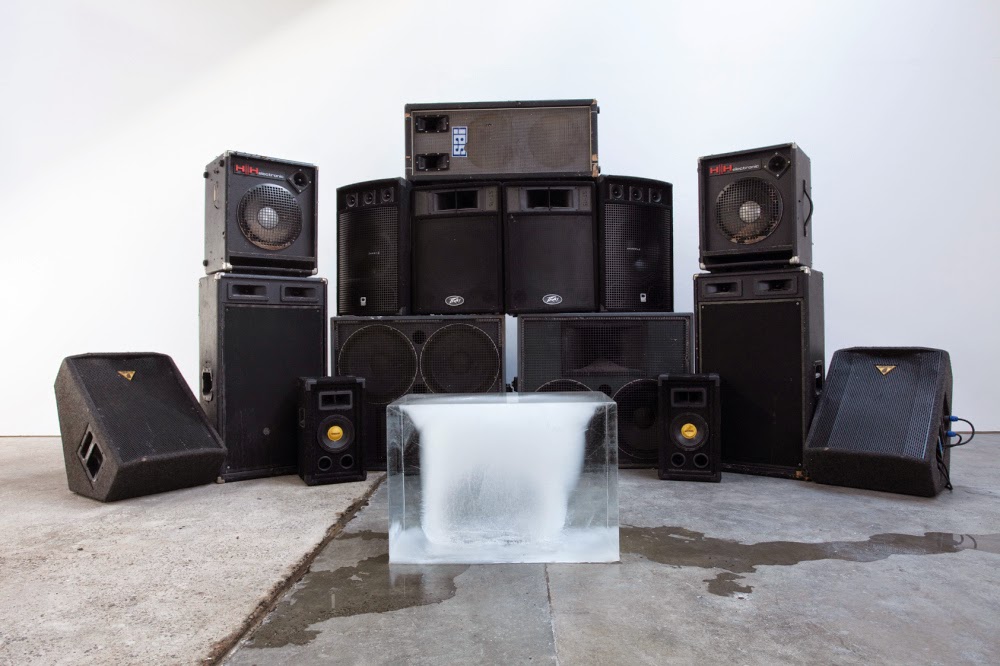
_______________
Shigeko Hirakawa Follow the Water (2014)
In Follow the Water, Hirakawa releases into the streams of Trévarez Domain park in Saint Goazec, France a mass of 1800 tons of water coloured with fluorescein and lets it flow down through the grounds into the pond.
_____________
Sophia Collier Grand (2013)
Grand is a 22-foot sculptural portrait of the Grand River after midnight. The work is comprised of three acrylic blocks carved into a realistic section of the river. To create the surface of Grand I developed a software model of wind and current in the Grand Rapids’ area and incorporated patterns of sound waves from the region. The sounds came from various sources, including my own on-site recordings, oral histories and music, as well as those provided by the public. The work itself, while using sound in its design, is silent, reflecting the stillness of deep night when dreaming and rest are resolving all that has occurred.
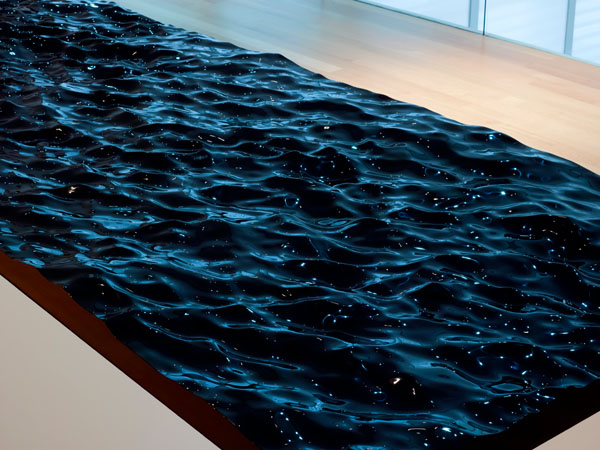

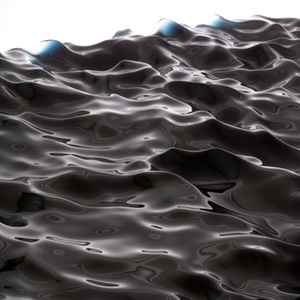
________________
Eric Tillinghast Rain Machine (2012)
Water is the inspiration, the medium and the subject inside the work of American artist Eric Tillinghast. His work takes the form of paintings, sculptures and installations where water becomes the protagonist. In Rain Machine, a large rectangular basin of water is moved by a pump while from the top a drip system makes the water fall on the surface.
________________
Jan Fabre The man writing on water (2006)
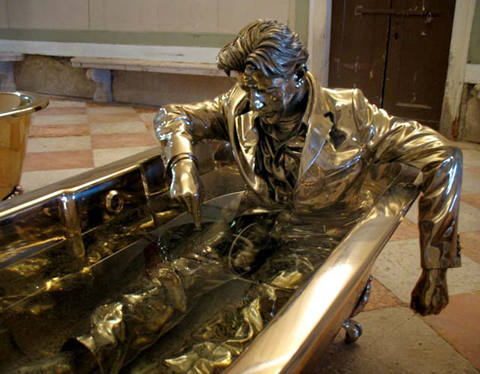
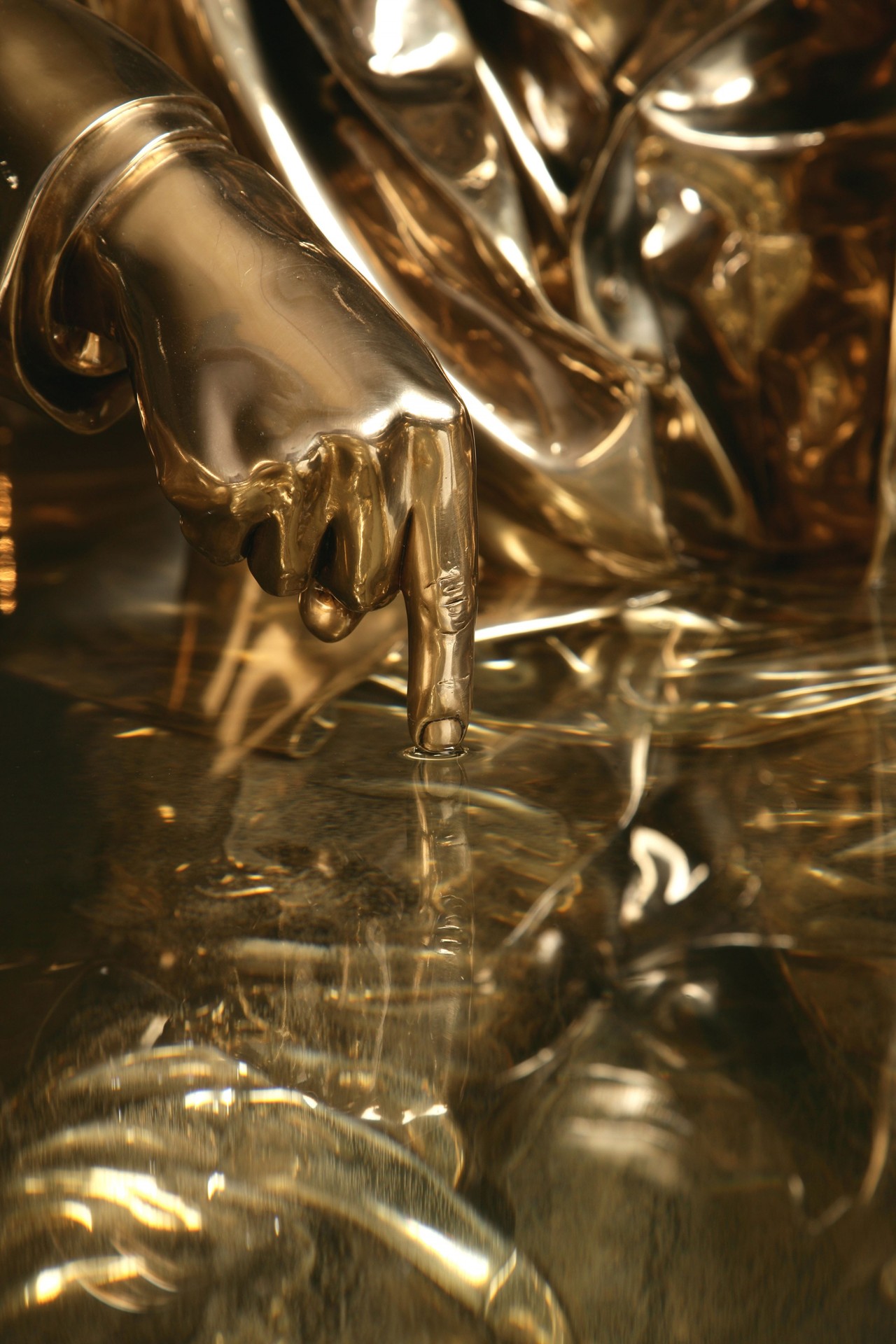
________________
Jeppe Hein Hexagonal Water Pavilion (2007)
The form of the water pavilion is deduced from the isometric view of a cube, composed of ten interior water walls surrounded by six perimeter walls, giving the top view the appearance of a cube nested in a hexagonal structure. The 2.5-metre-high water walls systematically rise and fall, delineating all possible configurations of the space in defined sequences before changing shape and appearance. Initially the pavilion looks inaccessible, but soon it becomes evident that the wall of water is divided into sections and the visitors are able to move between spaces within the structure. Visitors find themselves enclosed in ever-changing interior spaces or suddenly pushed to the exterior, without any means to control the confinement or exclusion.
_______________
Tokujin Yoshioka Stellar (2011)
The chandelier is based on Tokujin’s attempt of creating an artificial star, but in a spherical form. Focusing on the beauty born out of coincidence during the formation process of natural ice crystals, ‘stellar’ is the result of Tokujin’s ongoing research development of growing ice crystals within an aquarium.
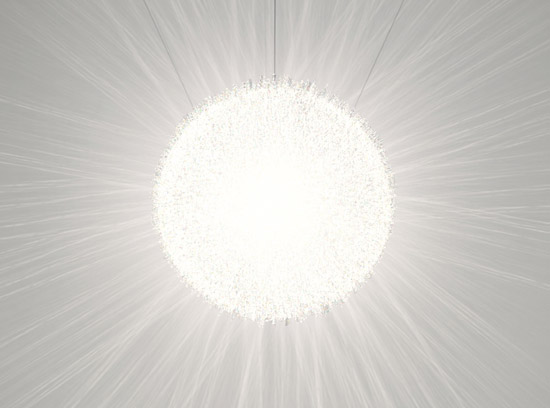

______________
Martijn van Wagtendonk Trickle Into a Lower Chamber (2009)
Suspended 6-feet and a couple of inches above the floor and pond is van Wagtendonk’s wooden boat. He built the 16-foot dinghy himself after finding plans he liked more than any craft he considered buying. Some 300 wind-up mechanical birds are stationed underneath the hull and await viewers, whose approaches trigger the random pecking. To accomplish this, van Wagtendonk gutted each of the birds and inserted his own mechanics, which are a mix of electronic parts that make up “analog randomness. The boat and bird are situated in a dim gallery space lit by a host of small bulbs that variously glow, depending on where the viewer stands. The lights reflect on a floor surface made of a solid black layer of water. The shallow square pond receives intermittent drops of moisture from above. But where the water comes from is unclear because of the ceiling’s darkness.
_______________
Mary Ma Wind Water Wave (2016)
Mary Ma’s Wind Water Wave is a 50 foot long polyester fabric that cascades from the ceiling. This fabric is blown by high powered fans, causing a continuous series of waves that ripple to the ground. Video projectors mounted in the ceiliing light up the fabric with the imagery of moving water recorded on the shore of Lake Ontario.

_______________
Fujiko Nakaya Fog Bridge (2015)
Each time the haze appears its form and reach alters, twisting and dissipating on the quay’s incoming wind. Sometimes the pedestrian traffic is lost within it, silhouettes and ghosts. Other times the cloud is instantly lifted and forms a kind of crown around the gramophone horns. The piece is called—what else?—Fog Bridge. It’s a simple proposition and pedestrians using the bridge react in many different ways. For a moment you might be in an urban cloud forest, enveloped, lost. You might think about changing global weather or your place in the planet’s ecology. After dark, under the streetlights, those old enough to remember could recall the London smog. Or you could just get pissed off that your clothes are getting slightly wet. But Fog Bridge does feel modern, in its wry, open invitation—best experienced without justification, its meanings owned by those who stumble upon it.
*
p.s. Hey. ** David Ehrenstein, Hi. I only know the obvious Ravel track, embarrassingly. ** Jeff J, Hi. Surprise! Yeah, I was happy to come across it in the Weaklings morgue. Thank you for it again. Your new commenting methodology worked, obviously. Cool. To start with Majewski? Mm, I would say maybe ‘The Mill and the Cross’? Glad the writing class experience went so well. What a great context. Gisele is in Spain right now getting ready for a ‘Crowd’ performance and mega-preoccupied, but we’re supposed to finally talk this afternoon, and I’ll let you know. ** Tosh Berman, Hi, Tosh! I hope the roll-out of your book is as pleasurable and successful as it sure appears to be from over here. I want to be there for that marathon Michael-plus-Sparks chat. And awesome that you’re weighing in for the doc. Was it fun? Did ‘they’ ask the right questions? ** Keatoncado, If it weren’t for that pesky ‘c’ I would be imagining a freaky ‘Sharkanado’ spin-off. There at least used to be a gay park in Paris. I guess there probably still is. The guys I know who used to go there are either partnered or celibate now. I admire your straightforward approach. Bret’s funny. Being on his show is like being his audience with the occasional pop question, which is relaxing. Thanks. I’ve tried to max out my SoCal gift/limits. I hope the sun was good. Well, and the writing, obviously. ** Bill, Hi. Me too. Thanks about Bookworm. It was unexpectedly fun. Michael was in a good mood. Long trip … another overseas one? Ha ha, wow, that urban dictionary thing. If I actually knew Richard rather than just liking what he does from afar, I’d link him up, but, not knowing him, and knowing my rep., I think not. ** Corey Heiferman, Hi. Interesting, that proverb. I think so. That video looks enticing, yeah. Thanks. As soon I get back from where I need to go in about five minutes, I’ll hit it. Steve had some words for you yesterday in case you missed them. ** Steve Erickson, Ah, good about the interview apart from the tech issue. I think I remember when you were hoping to interview Assayas about his music tastes. That is an awfully good idea. And I hope it happens someday. ** liquoredgoat, Well, hi there, my friend. I just moments ago saw an FB message from you. I’m very sorry to learn about the roughness. I hope that you popping in is a sign that things are smoothing. You’re back in CA! In SD? Yeah, obviously, hang out when you feel like it as it would be great to catch up. ** Okay. Keyword: water. See you tomorrow.




 Now available in North America
Now available in North America 
I do love that Orozco pond in the ping pong table, seems to me that any art space would benefit from having it as a permanent installation in their canteen.
Yesterday was the panel meeting for the Visual Artist and Craft Maker Awards application I made recently. I was after some funding for The Call zine that I’ve been covertly working on of late, and I learn of their decision within 14 days. If the app doesn’t succeed then I’ll still make the thing but getting the funding would be a major help, fingers crossed etcetera.
Haha, I didnt get that forever. I was like Huh? Haha. Ive been in a couple hurricanes. The last got so bad I took a hand full of pills and kicked the boy out and slept through it. I feel like there is no clean water. I like tap water. The oceans seem like septic to me. And theres Sharnados everywhere. I love waterfalls. My uncle made this great water thing in his house like an indoor coyfish pond thing. I was just thinking the endless doors of my Parisian Emerald Chateau apartment will lead to something strange like an aquarium room with sharks or a stone stairway lit with torches to be Sadeian and worship the Devil. The interview was candid and revealing. Even it went over a lot of familiar ground there were great emotional nuances and insights. For example, when Bret said, “It’s a beautiful movie!” he was so right. Bret is like popcorn chicken and the rarest tequila. A writers writer for sure. Didn’t make it to the beach, going today. 5 pages of a possible “novel” written. I like what its doing so far. Its being a weird little booger.
The Waters of March
And here’s a Medley from Tom and The Chairman of The Board
Ravel was a great composer and a Mad Queen (often given to drag) Here’s an opera he wrote for children about cats</A.. No it's not at all like the Andrew Lloyd Webber monstrosity
Correction:
Here’s the Ravel mini-opera
Here’s “Cats”
Hey Dennis – Nice water features here. Something very calming about watching the videos of these pieces. I’ve seen that ping pong table and love it. The Rain Machine particularly struck me as well, for whatever reason.
Glad the new commenting method worked! I can’t tell until the next day.
Just read ‘Learning What Love Means’ which you highlighted here a while ago and thoroughly enjoyed it. Have any of Mathieu Lindon’s novels been translated into English? Or do you know people who’ve read them in French? They sounded interesting.
Thanks for asking Giselle. Hope the production of ‘Crowd’ is going well.
Assayas’ publicist got back to me again today. She seems intrigued by the unusual nature of my interview request, and now there’s a possibility he might be able to make time to talk to me, but it’s up in the air at the moment.
I spent a lot of time today trying to hash out the final arrangements for the Kamran Heidari series at Spectacle. The schedule and my program notes should go up on their website Monday. I will post a link here once they’re live. We’re trying to figure out a day to do a Q&A after one of the screenings via Google hangout. Due to the time difference in Shiraz, Iran, he’ll have to get up at 4 AM to do it if we start around 9 PM in New York, which he’s perfectly willing to do, but he will likely be lying in bed in front of his laptop. We’re also trying to figure out if we can get any press.
Wait what are you supposed to do with that ping pong table if a ball lands in the water? Would you need a pool-cleaning net to fish it out?
As a kid I was mesmerized by the waterfall behind glass you can sit under at the New York Aquarium:
https://www.youtube.com/watch?v=I-u4bxkxPfA
The Chicago River dyed green for St. Patrick’s Day:
https://www.youtube.com/watch?v=CSb9HcckqHM
An image well chosen as marketing for “Out 1”:
And finally, I happened to watch Hollis Frampton’s “Surface Tension” recently and lo and behold it fits this post’s theme:
https://www.youtube.com/watch?v=6U6A-bjeMh4
i heard mcelroy is finally close to finishing his lengthy years-in-the-making book on water
ridiculously sick right now
,
worse than last time i commented , drinking much water myself
hope all is well with you
j